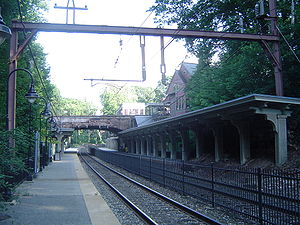Glen Ridge | |||||||||||||||||||||||
|---|---|---|---|---|---|---|---|---|---|---|---|---|---|---|---|---|---|---|---|---|---|---|---|
 Glen Ridge station | |||||||||||||||||||||||
| General information | |||||||||||||||||||||||
| Location | 224 Ridgewood Avenue (CR 653), Glen Ridge, New Jersey | ||||||||||||||||||||||
| Coordinates | 40°48′01″N74°12′15″W / 40.8002°N 74.2043°W | ||||||||||||||||||||||
| Owned by | New Jersey Transit | ||||||||||||||||||||||
| Platforms | 2 side platforms | ||||||||||||||||||||||
| Tracks | 2 | ||||||||||||||||||||||
| Connections | (all buses on Bloomfield Avenue) | ||||||||||||||||||||||
| Other information | |||||||||||||||||||||||
| Station code | 603 (Delaware, Lackawanna and Western) [1] | ||||||||||||||||||||||
| Fare zone | 4 | ||||||||||||||||||||||
| History | |||||||||||||||||||||||
| Opened | 1860 [2] | ||||||||||||||||||||||
| Rebuilt | 1872; [2] 1887 [2] | ||||||||||||||||||||||
| Electrified | September 3, 1930 [3] | ||||||||||||||||||||||
| Previous names | Ridgewood [4] | ||||||||||||||||||||||
| Passengers | |||||||||||||||||||||||
| 2017 | 1,410 (average weekday) [5] [6] | ||||||||||||||||||||||
| Services | |||||||||||||||||||||||
| |||||||||||||||||||||||
| |||||||||||||||||||||||
| |||||||||||||||||||||||
Glen Ridge is a New Jersey Transit station at the intersection of Bloomfield Avenue and Ridgewood Avenue in Glen Ridge, Essex County, New Jersey along the Montclair-Boonton Line. Service through Glen Ridge comes from Hoboken Terminal and New York Penn Station and goes through to one of four termini, Bay Street (on weekends), Montclair State University, Dover and Hackettstown. The station depot is on-grade level with Ridgewood Avenue, with the platform and tracks below street-level.

